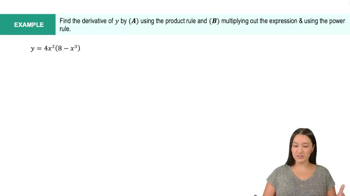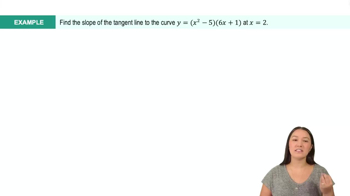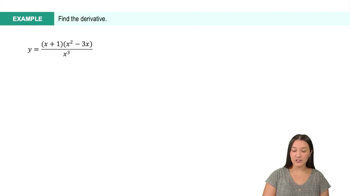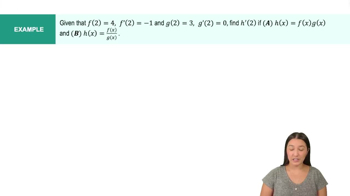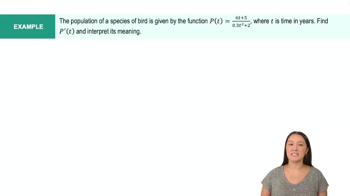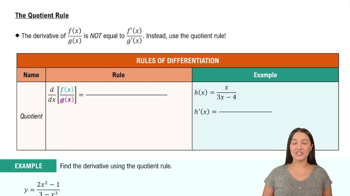Table of contents
- 0. Functions7h 52m
- Introduction to Functions16m
- Piecewise Functions10m
- Properties of Functions9m
- Common Functions1h 8m
- Transformations5m
- Combining Functions27m
- Exponent rules32m
- Exponential Functions28m
- Logarithmic Functions24m
- Properties of Logarithms34m
- Exponential & Logarithmic Equations35m
- Introduction to Trigonometric Functions38m
- Graphs of Trigonometric Functions44m
- Trigonometric Identities47m
- Inverse Trigonometric Functions48m
- 1. Limits and Continuity2h 2m
- 2. Intro to Derivatives1h 33m
- 3. Techniques of Differentiation3h 18m
- 4. Applications of Derivatives2h 38m
- 5. Graphical Applications of Derivatives6h 2m
- 6. Derivatives of Inverse, Exponential, & Logarithmic Functions2h 37m
- 7. Antiderivatives & Indefinite Integrals1h 26m
- 8. Definite Integrals4h 44m
- 9. Graphical Applications of Integrals2h 27m
- 10. Physics Applications of Integrals 2h 22m
3. Techniques of Differentiation
Product and Quotient Rules
Problem 92a
Textbook Question
Suppose the line tangent to the graph of f at x=2 is y=4x+1 and suppose y=3x−2 is the line tangent to the graph of g at x=2. Find an equation of the line tangent to the following curves at x=2.
y = f(x)g(x)
 Verified step by step guidance
Verified step by step guidance1
Step 1: Identify the given information. We have two functions, f(x) and g(x), with their respective tangent lines at x=2. The tangent line to f(x) at x=2 is y=4x+1, which implies that f'(2)=4 and f(2) is the y-value when x=2, which can be found by substituting x=2 into the equation of the tangent line. Similarly, the tangent line to g(x) at x=2 is y=3x−2, which implies that g'(2)=3 and g(2) is the y-value when x=2, found by substituting x=2 into the equation of the tangent line.
Step 2: Use the product rule to find the derivative of y=f(x)g(x). The product rule states that if y=u(x)v(x), then y'=u'(x)v(x) + u(x)v'(x). Here, u(x)=f(x) and v(x)=g(x), so y'=f'(x)g(x) + f(x)g'(x).
Step 3: Substitute x=2 into the derivative found in Step 2. This gives y'(2)=f'(2)g(2) + f(2)g'(2).
Step 4: Substitute the known values from Step 1 into the expression from Step 3. We have f'(2)=4, g'(2)=3, and the values of f(2) and g(2) can be found from the tangent line equations.
Step 5: Use the result from Step 4 to write the equation of the tangent line to y=f(x)g(x) at x=2. The equation of a tangent line is y-y_1=m(x-x_1), where m is the slope found in Step 4, and (x_1, y_1) is the point on the curve at x=2, which can be found by evaluating y=f(x)g(x) at x=2.
 Verified video answer for a similar problem:
Verified video answer for a similar problem:This video solution was recommended by our tutors as helpful for the problem above
Video duration:
6mPlay a video:
Was this helpful?
Key Concepts
Here are the essential concepts you must grasp in order to answer the question correctly.
Tangent Line
A tangent line to a curve at a given point is a straight line that touches the curve at that point without crossing it. The slope of the tangent line represents the derivative of the function at that point, indicating the rate of change of the function. In this problem, the equations of the tangent lines for functions f and g at x=2 provide the necessary slopes for further calculations.
Recommended video:
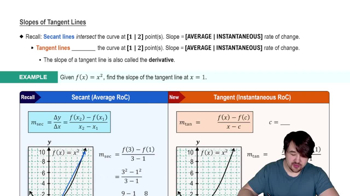
Slopes of Tangent Lines
Product Rule
The Product Rule is a fundamental differentiation rule used when finding the derivative of the product of two functions. It states that if u(x) and v(x) are two differentiable functions, then the derivative of their product is given by u'v + uv'. This rule is essential for determining the derivative of the product of f(x) and g(x) at x=2 in the given problem.
Recommended video:
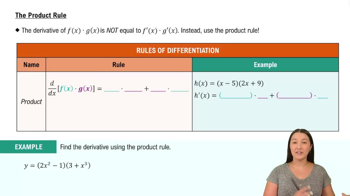
The Product Rule
Chain Rule
The Chain Rule is a method for differentiating composite functions. It states that if a function y is composed of another function u, then the derivative of y with respect to x is the derivative of y with respect to u multiplied by the derivative of u with respect to x. While not directly applied in this problem, understanding the Chain Rule is important for more complex scenarios involving nested functions.
Recommended video:

Intro to the Chain Rule
Related Videos
Related Practice



